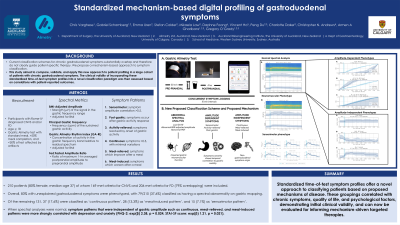Sunday Poster Session
Category: Stomach
P1342 - Physiology-Guided, Mechanism-Based Digital Phenotyping of Gastroduodenal Symptoms
Sunday, October 22, 2023
3:30 PM - 7:00 PM PT
Location: Exhibit Hall

Has Audio
- GO
Greg O'Grady, MBChB, PhD
University of Auckland
Auckland, Auckland, New Zealand
Presenting Author(s)
Chris Varghese, MBChB1, Gabriel Schamberg, PhD2, Stefan Calder, PhD1, Mikaela Law, PhD1, Daphne Foong, 3, Vincent Ho, MD3, Peng Du, PhD1, Charlotte Daker, MBChB4, Christopher Andrews, MD5, Armen Gharibans, PhD1, Greg O'Grady, MBChB, PhD1
1University of Auckland, Auckland, Auckland, New Zealand; 2Alimetry Ltd., Auckland, Auckland, New Zealand; 3Western Sydney University, Western Sydney, New South Wales, Australia; 4Te Whatu Ora - Waitematā, Auckland, Auckland, New Zealand; 5University of Calgary, Calgary, AB, Canada
Introduction: Current classification schemes for chronic gastroduodenal symptoms substantially overlap and therefore do not clearly guide patient-specific therapy. We hypothesised that a mechanism-based approach to symptom classification may offer a valid and more specific alternative scheme.
Methods: We performed a multicentre, prospective cohort study of patients meeting Rome-IV criteria for functional dyspepsia (FD) and chronic nausea and vomiting syndromes (CNVS). Gastric Alimetry™ (Alimetry, New Zealand) was used for body surface gastric mapping spectral analysis and time-of-test symptom profiling. A standardised digital classification framework separated patients into those with a) abnormal spectral analyses (suspected neuromuscular pathologies); normal spectral analyses with b) symptoms correlated to gastric amplitude (sensorimotor, post-gastric, and activity-relieved); and c) symptoms independent of gastric amplitude (continuous, meal-relieved, meal-induced).
Results: 210 patients (80% female, median age 37) of whom 169 met criteria for CNVS and 206 met criteria for FD (79% overlapping) were included. Overall, 83% with unexplained gastroduodenal symptoms were phenotyped, with 79/210 (37.6%) classified as having a spectral abnormality on gastric mapping. Of the remaining 131, 37 (17.6%) were classified as ‘continuous pattern’, 28 (13.3%) as ‘meal-induced pattern’, and 15 (7.1%) as ‘sensorimotor pattern’. When spectral analyses were normal, symptom patterns that were independent of gastric amplitude such as continuous, meal-relieved, and meal-induced patterns were more strongly correlated with depression and anxiety (PHQ-2: exp(β) 2.38, p = 0.024), STAI-SF score: exp(β) 1.21, p = 0.021).
Discussion: Standardised time-of-test symptom profiles offer a novel approach to classifying patients based on proposed mechanisms of disease. These groupings correlated with chronic symptoms, quality of life, and psychological factors, demonstrating initial clinical validity.
Disclosures:
Chris Varghese, MBChB1, Gabriel Schamberg, PhD2, Stefan Calder, PhD1, Mikaela Law, PhD1, Daphne Foong, 3, Vincent Ho, MD3, Peng Du, PhD1, Charlotte Daker, MBChB4, Christopher Andrews, MD5, Armen Gharibans, PhD1, Greg O'Grady, MBChB, PhD1. P1342 - Physiology-Guided, Mechanism-Based Digital Phenotyping of Gastroduodenal Symptoms, ACG 2023 Annual Scientific Meeting Abstracts. Vancouver, BC, Canada: American College of Gastroenterology.
1University of Auckland, Auckland, Auckland, New Zealand; 2Alimetry Ltd., Auckland, Auckland, New Zealand; 3Western Sydney University, Western Sydney, New South Wales, Australia; 4Te Whatu Ora - Waitematā, Auckland, Auckland, New Zealand; 5University of Calgary, Calgary, AB, Canada
Introduction: Current classification schemes for chronic gastroduodenal symptoms substantially overlap and therefore do not clearly guide patient-specific therapy. We hypothesised that a mechanism-based approach to symptom classification may offer a valid and more specific alternative scheme.
Methods: We performed a multicentre, prospective cohort study of patients meeting Rome-IV criteria for functional dyspepsia (FD) and chronic nausea and vomiting syndromes (CNVS). Gastric Alimetry™ (Alimetry, New Zealand) was used for body surface gastric mapping spectral analysis and time-of-test symptom profiling. A standardised digital classification framework separated patients into those with a) abnormal spectral analyses (suspected neuromuscular pathologies); normal spectral analyses with b) symptoms correlated to gastric amplitude (sensorimotor, post-gastric, and activity-relieved); and c) symptoms independent of gastric amplitude (continuous, meal-relieved, meal-induced).
Results: 210 patients (80% female, median age 37) of whom 169 met criteria for CNVS and 206 met criteria for FD (79% overlapping) were included. Overall, 83% with unexplained gastroduodenal symptoms were phenotyped, with 79/210 (37.6%) classified as having a spectral abnormality on gastric mapping. Of the remaining 131, 37 (17.6%) were classified as ‘continuous pattern’, 28 (13.3%) as ‘meal-induced pattern’, and 15 (7.1%) as ‘sensorimotor pattern’. When spectral analyses were normal, symptom patterns that were independent of gastric amplitude such as continuous, meal-relieved, and meal-induced patterns were more strongly correlated with depression and anxiety (PHQ-2: exp(β) 2.38, p = 0.024), STAI-SF score: exp(β) 1.21, p = 0.021).
Discussion: Standardised time-of-test symptom profiles offer a novel approach to classifying patients based on proposed mechanisms of disease. These groupings correlated with chronic symptoms, quality of life, and psychological factors, demonstrating initial clinical validity.
Disclosures:
Chris Varghese indicated no relevant financial relationships.
Gabriel Schamberg: Alimetry Ltd. – Employee.
Stefan Calder: Alimetry Ltd – Intellectual Property/Patents, Owner/Ownership Interest.
Mikaela Law: Alimetry Ltd. – Employee.
Daphne Foong: Alimetry Ltd. – Employee.
Vincent Ho indicated no relevant financial relationships.
Peng Du: Alimetry Ltd. – Employee.
Charlotte Daker: Alimetry Ltd – Consultant.
Christopher Andrews: Alimetry Ltd – Consultant.
Armen Gharibans: Alimetry Ltd. – Employee, Owner/Ownership Interest.
Greg O'Grady: Alimetry Ltd. – Employee, Owner/Ownership Interest. The Insides Company – Owner/Ownership Interest.
Chris Varghese, MBChB1, Gabriel Schamberg, PhD2, Stefan Calder, PhD1, Mikaela Law, PhD1, Daphne Foong, 3, Vincent Ho, MD3, Peng Du, PhD1, Charlotte Daker, MBChB4, Christopher Andrews, MD5, Armen Gharibans, PhD1, Greg O'Grady, MBChB, PhD1. P1342 - Physiology-Guided, Mechanism-Based Digital Phenotyping of Gastroduodenal Symptoms, ACG 2023 Annual Scientific Meeting Abstracts. Vancouver, BC, Canada: American College of Gastroenterology.
